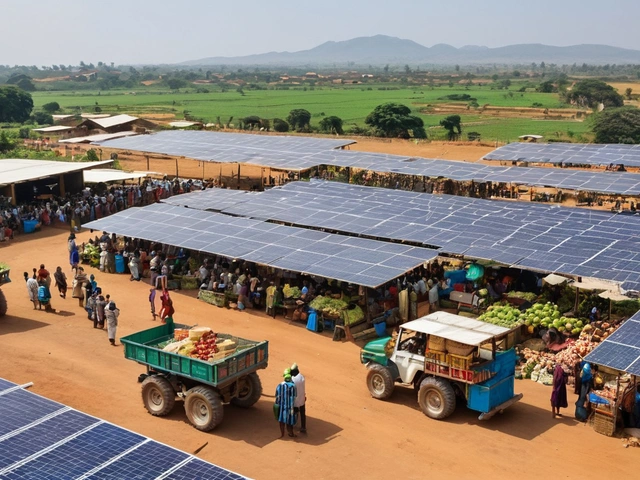High unemployment rates can be troubling for any country, and Ethiopia is no exception. There are multiple reasons why Ethiopia is struggling with this issue, ranging from economic to educational challenges. This article seeks to shed light on the underlying causes and explore possible solutions that could help address the situation.
The youth unemployment rate in Ethiopia is alarmingly high. Many young people are entering the job market each year, but the economy isn't growing at a pace to provide enough opportunities. This mismatch creates a growing pool of job seekers without jobs. Additionally, the education system in Ethiopia is not always aligned with the skills needed in the job market, leaving many graduates unprepared for available positions.
Another significant factor is the country’s ongoing economic transition. Moving from an agrarian-based economy to one that is more industrialized comes with its own set of challenges. In the short term, this transition may lead to job losses in traditional sectors, while new sectors haven't yet grown enough to absorb the displaced workers.
On a more hopeful note, understanding these challenges is the first step toward addressing them. By focusing on vocational training, fostering entrepreneurship, and creating policies that bridge the gap between education and industry needs, Ethiopia can begin to reduce its unemployment rate. Encouraging foreign investment and improving infrastructure may also play crucial roles in this process.
- Economic and Demographic Factors
- Educational Challenges
- Economic Transition and Development
- Potential Solutions and Future Outlook
Economic and Demographic Factors
The unemployment rate in Ethiopia can be traced back to a mix of economic and demographic factors. The country has a young and rapidly growing population. Nearly 70% of the Ethiopian population is under the age of 30, a fact that underscores the immense pressure on the job market to generate new employment opportunities. The nation’s annual population growth rate is about 2.5%, which means that millions of young people enter the working-age population each year.
Additionally, Ethiopia's economy is heavily dependent on agriculture, which employs around 70% of the country's workforce but contributes less than half of the GDP. This sector, while crucial, is often susceptible to climate changes and price volatility, making it an unreliable source of sustained employment. With limited industrial growth, the transition to more stable and higher-paying jobs in other sectors is slow. Many young Ethiopians remain stuck in low-paying, seasonal agricultural jobs with little prospect for advancement.
Urbanization is another contributing factor. Although the urban population is growing rapidly as people move to cities in search of better opportunities, job creation in urban areas hasn't kept up with this influx. Consequently, urban unemployment rates are significantly higher than rural rates, exacerbating the issue. Cities like Addis Ababa are experiencing to a high rate of migration, placing added pressure on city resources and employment markets.
The country's economic policies have also played a role. For years, Ethiopia pursued state-led development with a focus on large-scale public infrastructure projects such as railways, roads, and industrial parks. While these projects have created jobs, they are often temporary and concentrated in specific sectors, failing to address the broader unemployment challenges. The slow growth of the private sector further limits its ability to absorb the growing workforce. According to a 2022 report by the International Labour Organization (ILO), private businesses face numerous obstacles, including bureaucratic red tape and challenges in accessing finance, which stymies job creation.
"The youth are the most affected by unemployment, not because they lack potential, but because there are simply not enough opportunities," says Abebe Kebede, an Ethiopian labor economist. "Without robust economic diversification and targeted job creation policies, it will be difficult to turn the tide."
Complicating matters, Ethiopia's political stability has been volatile, with periodic conflicts and civil unrest disrupting economic activities. For instance, the recent internal conflicts in the Tigray region have led to significant economic disruption and displacement, further straining the job market. Businesses in conflict-affected areas often close down, and the lack of investor confidence hinders new ventures, making it tough for the affected locales to bounce back quickly.
Lastly, economic disparity between regions also contributes to the high unemployment rate. While some areas, like Addis Ababa and the Oromia region, have seen more economic growth and investment, other regions lag behind. This uneven development results in regional disparities in job creation and economic opportunities, leading to internal migration and further stressing urban job markets.

Educational Challenges
One of the critical issues contributing to Ethiopia's high unemployment rate is the challenge within the educational system. Many students in the country face difficulties accessing quality education, often due to limited resources. Schools, especially in rural areas, frequently lack basic infrastructure like proper classrooms, textbooks, and skilled teachers. This situation creates a major gap in educational attainment and skill levels that hinders job prospects for many young Ethiopians.
Moreover, the curriculum in Ethiopian schools does not always match the needs of the job market. Many graduates find themselves with degrees that do not translate into employable skills. For instance, there's a considerable focus on theoretical knowledge, with less emphasis on practical, vocational training. This disconnect leaves students ill-prepared for job opportunities, particularly in growing industries like technology and manufacturing, where hands-on skills are crucial.
A significant factor in this is the limited investment in technical and vocational education training (TVET). During 2020, the enrollment rates in TVET programs were relatively low, representing only 7% of the student population. This issue stems from past policies that prioritized university education at the expense of vocational training. However, in recent years, there has been a shift in policy, with the government making concerted efforts to promote TVET as a viable option for enhancing employability among the youth.
Additionally, language barriers also play a role. While Amharic is the official language, many regions have their own local languages, complicating the standardization of educational content. This issue becomes particularly pronounced in higher education, where courses are often conducted in English. Many students, particularly those from rural backgrounds, struggle with the transition, resulting in lower academic performance and limited job readiness.
According to a World Bank report, “Only a quarter of secondary school graduates possess the minimum required skills for entry-level jobs in Ethiopia's key economic sectors.”This striking statistic highlights the urgent need to reform the educational system to better align with market demands and improve the quality of education at all levels.
An encouraging development is the growing emphasis on public-private partnerships to enhance education. Major corporations have begun collaborating with educational institutions to design curriculums that are more relevant to current industry standards and to offer internships that provide practical experience. These partnerships are crucial in creating a more dynamic and responsive educational system that prepares students for the modern workforce.
To tackle these challenges effectively, it’s essential to focus on holistic reforms. These should include improving infrastructure, updating curriculums to include more practical and industry-relevant courses, and promoting TVET programs. By addressing these areas, Ethiopia can gradually reduce its unemployment rate and foster economic growth.

Economic Transition and Development
One of the main drivers of unemployment in Ethiopia is the country’s ongoing economic transition. Ethiopia is shifting from an agrarian-based economy to one that embraces more industrial and service-oriented sectors. This shift is vital for long-term growth but creates short-term disruptions in the job market. As traditional farming roles diminish, new roles in industries and services have not yet fully emerged, leaving many without employment.
The government’s efforts to enhance infrastructure, such as expanding road networks and improving telecommunications, are part of this transition. Projects like the Grand Ethiopian Renaissance Dam (GERD) are ambitious undertakings aimed at bolstering economic resilience. While these initiatives promise future job creation, the present reality often involves job displacement in sectors no longer deemed sustainable. Moreover, the industrial sector, particularly manufacturing, is still in its nascent stages, struggling to provide employment at the scale required.
Demographic trends compound the issue. Every year, around two million young Ethiopians enter the labor market. The current economic growth rate, while impressive on a macro level, isn't sufficient to absorb this influx of job seekers. This disconnect creates cycles of unemployment and underemployment, where people take jobs beneath their skill levels just to make ends meet. Additionally, the informal economy, which many turn to, lacks the stability and benefits offered by formal employment.
Another notable aspect is the role of foreign investment in Ethiopia's economic transition. Attracting foreign investors brings capital and expertise that are crucial for development. However, the regulatory environment, sometimes perceived as unpredictable, can deter potential investors. Creating a stable and transparent investment climate can help translate foreign interest into actual job opportunities.
There is also a pressing need to align educational outcomes with market needs. Many university graduates find themselves equipped with knowledge that does not meet the demands of the industries growing within the country. Technical and vocational education training (TVET) can play a key role in bridging this gap. Enhancing TVET programs to match industry standards will prepare the workforce for the jobs of tomorrow.
According to a report by the World Bank, approximately 80% of Ethiopia's population is engaged in agriculture. As the economy transitions, it's essential to provide pathways for agricultural workers to shift into new sectors. This could be achieved by promoting agribusiness and improving access to credit for small farmers, enabling them to diversify their income sources.
"Ethiopia's economic transformation holds great promise, but it must be managed carefully to avoid leaving large segments of the population behind. Balanced growth requires a focus on both industrial and social development." - World Bank Report
The challenges of economic transition are not unique to Ethiopia; many countries have navigated this complex path. However, understanding these dynamics and planning strategically can make the journey smoother. By investing in education, fostering entrepreneurship, and creating an enabling environment for businesses, Ethiopia can move towards a more balanced and inclusive economy.

Potential Solutions and Future Outlook
Addressing Ethiopia's high unemployment rate requires a multi-faceted approach, targeting various aspects of the economy and society. One of the key areas is vocational training. Many young people graduate from universities with degrees that don't directly translate to job skills. Expanding vocational training can help bridge the gap between education and the actual demands of the job market. Institutions focusing on practical skills such as welding, plumbing, and IT can provide more immediate employment opportunities.
Another important solution lies in promoting entrepreneurship. Ethiopia has a rich culture of small businesses, but aspiring entrepreneurs often lack access to capital and business training. Government and private sector initiatives that offer micro-loans, grants, and mentorship programs can empower individuals to start and grow their own businesses. Studies suggest that small and medium enterprises (SMEs) are the backbone of many economies and could have the same impact in Ethiopia.
Improving infrastructure can also play a crucial role. Better roads, reliable electricity, and improved internet connectivity can attract domestic and foreign investments. When businesses see an environment where they can thrive, they are more likely to set up operations, which in turn creates jobs. Notable projects such as the Grand Ethiopian Renaissance Dam (GERD) symbolize strides toward a more robust infrastructure, but continual progress is necessary.
The government can assist by creating policies that facilitate job growth. Incentives for industries that have high employment potential, such as textiles and agriculture processing, can encourage companies to hire locally. Revising labor laws to protect workers while also making it easier for businesses to scale can create a more dynamic job market.
Women's participation in the workforce is another untapped resource. Initiatives that focus on gender equality, such as equal pay, family-friendly workplace policies, and support for women entrepreneurs, can double the size of the pool of qualified workers. Ethiopia's demographic makeup shows a young and vibrant population, and fully utilizing this demographic can significantly reduce unemployment.
"Investing in education and vocational training can transform an individual's life choices and opportunities, thus creating a ripple effect benefiting society as a whole." - Aklilu Hailemichael, educational researcher.
Investments in sustainable agriculture and modern farming techniques can also absorb a large portion of unemployed individuals, especially in rural areas. Innovations in agriculture technologies can make farming more attractive and profitable.
The future outlook for Ethiopia's employment landscape is cautiously optimistic. While challenges persist, understanding and addressing these issues head-on with targeted policies and innovative solutions can pave the way for a more prosperous Ethiopia. The country's potential is vast, but realizing it will require coordinated efforts across government, private sectors, and civil society.

 High Demand Opportunities in Ethiopia: Profitable Ventures to Explore
High Demand Opportunities in Ethiopia: Profitable Ventures to Explore
 Exploring Common Occupations in Ethiopia: Agriculture, Technology, and Beyond
Exploring Common Occupations in Ethiopia: Agriculture, Technology, and Beyond
 Understanding Ethiopia's Economic Challenges: Reasons Behind its Low Income Status
Understanding Ethiopia's Economic Challenges: Reasons Behind its Low Income Status
 Why Ethiopia is a Must-Visit Destination: Culture, History, and Natural Beauty
Why Ethiopia is a Must-Visit Destination: Culture, History, and Natural Beauty
 Top Profitable Businesses in Africa: Revealing the Best Money-Makers
Top Profitable Businesses in Africa: Revealing the Best Money-Makers
ashli john
July 18, 2024 AT 17:41Great overview of Ethiopia's job challenges and it really gives hope that we can turn things around together! The focus on vocational training and entrepreneurship is exactly the kind of boost the youth need keep pushing forward
Kim Chase
July 19, 2024 AT 15:54Thanks for breaking this down its super helpful i especially liked the bit about TVET programs they could really bridge that skills gap for many young Ethiopians keep up the good work
David Werner
July 20, 2024 AT 14:08What they don't tell you is that the whole push for foreign investment is a front for hidden agendas the elites want to keep the labor force fragmented while they reap the profits the real power game is being played behind the scenes and the youth are just pawns in a grand geopolitical chessboard
Paul KEIL
July 21, 2024 AT 12:21The macroeconomic transition exhibits structural unemployment dynamics compounded by sectoral labor reallocation inefficiencies requiring policy interventions that leverage human capital augmentation and market elasticity
Horace Wormely
July 22, 2024 AT 10:34The article accurately identifies the mismatch between educational outputs and labor market demand, and emphasizes the necessity of aligning curricula with industry requirements to improve employability.
christine mae cotejo
July 23, 2024 AT 08:48Reading through this piece feels like watching a slow, deliberate unveiling of a nation's struggle, each paragraph a brushstroke that paints the stark reality faced by millions.
First, the demographic surge-a youthful population that should be a catalyst for growth instead becomes a pressure cooker of unmet expectations.
Second, the reliance on agriculture creates a fragile backbone, vulnerable to climate whims and price volatility, leaving workers in a perpetual state of precarity.
Third, the education system, though expanding, remains misaligned; graduates emerge with diplomas that rarely translate into marketable skills.
Fourth, the industrial transition is a double‑edged sword, promising future jobs while chopping away existing ones without immediate replacements.
Fifth, the urban migration wave swells city infrastructures, yet job creation lags far behind, fostering a burgeoning underclass.
Sixth, bureaucratic hurdles stifle private sector dynamism, choking the very engine that could absorb surplus labor.
Seventh, foreign investment holds promise, but regulatory opacity often deters the capital that could spark new enterprises.
Eighth, gender disparities persist, sidelining a substantial portion of the workforce that could otherwise contribute to economic vitality.
Ninth, the regional disparities create pockets of prosperity amid vast swaths of stagnation, perpetuating internal migration cycles.
Tenth, the informal economy, while providing a safety net, lacks stability and benefits, keeping workers trapped in a cycle of uncertainty.
Eleventh, policy initiatives focusing on vocational training and entrepreneurship appear as beacons, yet their implementation remains uneven.
Twelfth, infrastructure projects like GERD symbolize ambition, but their trickle‑down impact on ordinary employment is still nascent.
Thirteenth, the political volatility adds another layer of risk, discouraging sustained investment and growth.
Fourteenth, the World Bank and ILO suggestions underscore the need for systemic reforms that bridge education and industry.
Fifteenth, the path forward demands coordinated action across government, private sector, and civil society, a collaborative symphony to transform challenges into opportunities.
In sum, the tapestry of Ethiopia's unemployment crisis is complex, yet not immutable; with decisive, targeted measures, the nation can rewrite its economic narrative.
Douglas Gnesda
July 24, 2024 AT 07:01Excellent deep dive! To add, leveraging existing agricultural value chains with agro‑processing can create immediate jobs while the industrial sector scales up. Also, partnering with tech incubators could fast‑track SME growth, offering practical pathways for the youth.
Abhijit Pimpale
July 25, 2024 AT 05:14The policies lack coherence.
Eric DE FONDAUMIERE
July 26, 2024 AT 03:28Totally agree i think the govt needs to streamline the process and provide clear guidlines for investors it will boost confidence and create jobs fast
Pauline Herrin
July 27, 2024 AT 01:41While the article provides a comprehensive overview, it insufficiently addresses the systemic governance failures that perpetuate unemployment, thereby offering an overly optimistic perspective without substantive policy critique.
pradeep kumar
July 27, 2024 AT 23:54The optimism is misplaced; without structural reforms the situation will persist.
love monster
July 28, 2024 AT 22:08Great points all around – blending vocational training, SME support, and targeted infrastructure investments can really catalyze sustainable job creation for Ethiopia’s burgeoning youth population.